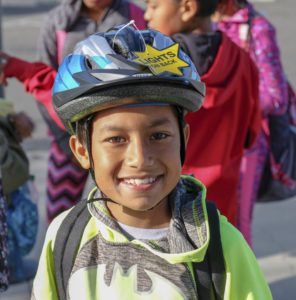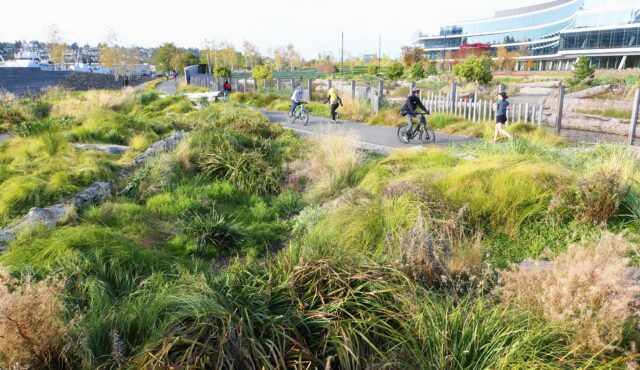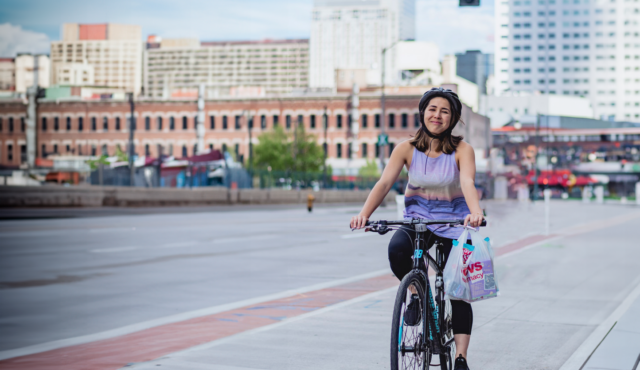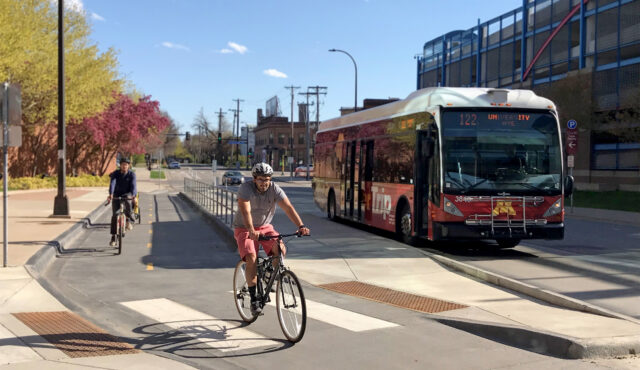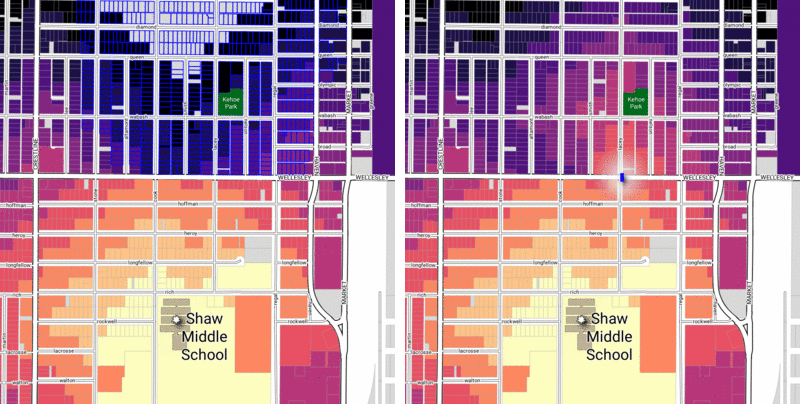
The way students get to and from school reveals a lot about a community. When parents can let their children walk, bike, or take the bus on their own, we know streets are safe and welcoming to people of all ages and abilities. At Toole Design, we have years of experience with Safe Routes to School (SRTS) planning and engineering, policy and curriculum development, and program evaluation. Read on for insights and advice that can benefit SRTS in your community!
A more nuanced approach to establishing SRTS
Toole Design is applying data analytics and research to identify mid-block and intersection infrastructure needs based on children’s physical and mental abilities.
A crossing that may be fine for an adult may not meet the needs of a child whose cognitive ability to judge the speed of approaching vehicles and gaps in traffic is less developed. Toole Design’s work in Spokane and Kirkland is taking into account roadway conditions such as vehicle speed and crossing distance to help those cities determine where and what type of infrastructure improvements are needed to make walking and biking routes safer and more viable options for children to get to school. Outputs from the analysis will help those cities prioritize infrastructure investments based on the number of children being served and other factors.
Incorporating Vision Zero and SRTS

Cities and states are realizing that traditional approaches to improving traffic safety aren’t working, especially for pedestrians. Between 2008 and 2017, the number of pedestrian fatalities in the U.S. increased by 35% while the combined number of all other traffic deaths declined by 6%. [1]
Vision Zero initiatives across the country aim to reverse that trend through a proactive approach to improving traffic safety for all road users by acknowledging human error and designing to mitigate the impact of crashes when they do happen. But change is hard, especially when it impacts long-established policies and procedures. Communities with an effective Vision Zero program rely on all community members to participate.
Increasingly, youth are part of Vision Zero work. By incorporating lessons learned from youth-focused initiatives such as Safe Routes to School, Vision Zero for Youth advances safety for youth (and everyone else) in all settings. Three key elements of this work include:
- Systemic safety analysis, which identifies high-risk roadway features in the entire network, then uses proven infrastructure changes to reduce the likelihood of crashes. Toole Design is completing a systemic safety analysis in Austin, Texas, where we provided SRTS recommendations for all city schools. We are also supporting the Pedestrian and Bicycle Information Center on a Vision Zero for Youth demonstration project with the City of Philadelphia which involves systemic safety analysis for school travel planning.
- SRTS programs that engage youth and inspire them to be community and civic leaders. Toole Design has developed youth-focused SRTS program in over 500 schools around the United States. Popular activities include walk audits, which provide a rich learning opportunity for students and adults alike about safe walking and biking environments for youth, and often motivates quick action by local officials.
- Community outreach and education, which promotes knowledge about safe ways to walk, bicycle, and drive. Toole Design’s community-centered approach ensures that Safe Routes to School outreach and education efforts fit each community in which we work so they have the best impact.
[1] Governor’s Highway Safety Association, Pedestrian Fatalities by State, 2018 Preliminary Data
Not just for the students, but with the students
Toole Design staff who attended the National SRTS Conference in November 2019 came home with one key lesson: students are not just an audience, but active participants and leaders. When given the chance to participate, students had a lot to say and to show us.
By teaming children with a GoPro camera, adults were able to experience what streets feel like to a young child – and experience just how large an approaching vehicle looks when you are under four feet tall! Bringing students to city hall was also powerful, allowing them to share their insights and recommendations about how to make it easier for them to travel safely to school. In addition to bringing great ideas to the table, students bring greater sense of civility in the public process among the adult participants. These stories reminded us that including students as leaders in planning not only makes stronger plans and projects, but also communities.
Coming back home to Washington from the conference, we brought with us the critical reminder of the value and the need to include students in SRTS efforts early on and to follow their lead. Our children are active users of spaces at and connecting to schools; have unique perspectives and recommendations; make us better adults; and are our fellow community members and should be included.
Meet our Washington STRS team
Many Toole Design staff have previously worked as local or state SRTS coordinators or have led SRTS programs at their children’s schools, giving our team an unrivaled level of firsthand experience and passion for this topic. Meet some of our Washington-based SRTS staff:

Carol Kachadoorian is a Senior Planner with decades of experience in multimodal transportation planning, policy development, and public engagement. Carol’s experience with SRTS includes direct assistance to school-based SRTS teams, outreach to a statewide audiences, and incorporating Vision Zero for Youth, which makes the important connection between Safe Routes to School and efforts to reduce all traffic deaths. Carol currently leads Toole Design’s work to develop a SRTS program in Orange County, CA, and has developed pedestrian and bicycle education curricula that includes teaching safety skills for students with disabilities.

Katie Knapp de Orvañanos is a planner in Toole Design’s Seattle office who has worked in transportation planning at the local and statewide level since 2011. Katie has intimate knowledge of policy development and program implementation in the public sector, and brings her specialization in inclusionary planning practices and bicycle and pedestrian volume estimation to Safe Routes to School projects. Katie’s recent work has focused on ways to better include youth with disabilities in SRTS programming through game-play and promotion of adaptive bicycles in bicycle education programs.

Spencer Gardner is an experienced data analyst and GIS specialist with years of experience assisting communities with multimodal transportation plans. Spencer has a broad base of knowledge in all aspects of transportation systems, from pro forma financial plans, transit ridership estimates, and travel market analysis, to data visualization, computer programming, and database management. In addition to his efforts on bicycle and pedestrian issues, he has worked with a number of transit agencies and understands the challenges and opportunities for building well-connected multimodal transportation systems. He is an avid SRTS supporter as he often bikes with his children to school and sees these issues firsthand.
Interesting in working together?
If you’re in the Washington area, contact our Seattle office to learn more about how we can help. Elsewhere? We have offices nationwide and in Canada – find the closest one to you here.
